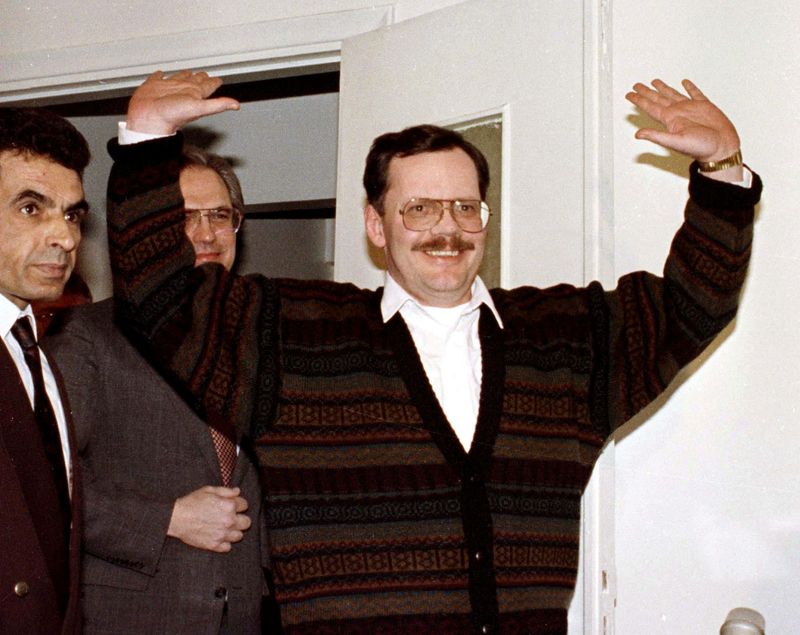By Alistar Bell
(Reuters) – Terry Anderson, a U.S. journalist held captive by Islamic militants for nearly seven years in Lebanon and who became a symbol of the plight of Western hostages during the country’s 1975-1990 civil war, died on Sunday at the age of 76 years, his former employer told the Associated Press.
Held in dimly lit cells by mostly Shiite Muslim groups in what was known as the hostage crisis, and shackled by the hands and feet and blindfolded much of the time, the former Marine later recalled that he “almost went mad ” and that only his Roman Catholic faith prevented him from taking his own life before being released in December 1991.
Anderson’s ordeal began in Beirut on the morning of March 16, 1985, after playing a game of tennis. A green Mercedes sedan with the rear window curtains up, three armed men jumped out and dragged Anderson, still dressed in shorts, into the car.
The pro-Iranian Islamic Jihad group claimed responsibility for the kidnapping, saying it was part of “continuing operations against the Americans.” The kidnappers have called for freedom for Shiite Muslims jailed in Kuwait over the attacks on the US and French embassies.
It was the beginning of a nightmare for Anderson that would last six years and nine months during which he was locked in cells beneath the rubble-strewn streets of Beirut and elsewhere, often poorly fed and sleeping on a thin, dirty mattress on a concrete floor. cement. .
During his captivity, both his father and brother would die of cancer and he would not see his daughter, born three months after his abduction, until she was six.
“What kept me going?” she asked aloud shortly after the release. “My teammates. I’ve been lucky enough to have people with me most of the time. My faith, stubbornness. Do what you have to. You wake up every day, gather energy from somewhere. You think you don’t have it and you get through the day and you do it day after day after day.”
Other hostages described Anderson as tough and active in captivity, learning French and Arabic and exercising regularly.
However, they also described banging their heads against a wall until they bled out of frustration at the beatings, isolation, false hopes and feelings of being neglected by the outside world.
“There’s a limit to how much we can hold out and some of us are getting very close to that limit,” Anderson said in a videotape released by his captors in December 1987.
Marcel Fontaine, a French diplomat released in May 1988 after three years of captivity, recalled the moment when cellmate Anderson thought freedom was near because he had been allowed to see the sun and eat a hamburger.
In April 1987 Anderson received a suit that his captors had made for him. “He wore it every day,” Fontaine said.
A week later, however, Anderson’s captors resumed their case, leaving him desperate and certain he had been forgotten, Fontaine said.
Dozens of journalist groups, governments and individuals over the years have called for Anderson’s release, and his birthday, October 27, has become an unofficial day of remembrance for hostages in the United States.
Anderson said he considered killing himself several times but rejected it. He relied heavily on his faith, which he said he had renewed six months before he was kidnapped.
“I must have read the Bible 50 times cover to cover,” he said. “It was a huge help to me.”
His sister, Peggy Say, who died in 2015, was his staunchest supporter during his imprisonment.
He worked tirelessly for his brother’s freedom. He visited Arab and European capitals, lobbied the Pope, the Archbishop of Canterbury and every available US official and politician.
Under pressure from the media and the families of the American hostages, the Reagan administration negotiated a secret and illegal deal in the mid-1980s to facilitate arms sales to Iran in exchange for the release of the American hostages. But the agreement, known as the Iran-Contra affair, failed to secure the freedom of any of the hostages.
Born on October 27, 1947 in Lorain, Ohio, Anderson grew up in Batavia, New York. He graduated from Iowa State University and spent six years in the Marine Corps, primarily as a journalist.
He worked for the AP in Detroit, Louisville, New York, Tokyo, Johannesburg and then Beirut, where he first went to cover the 1982 Israeli invasion.
In that war-torn city, he fell in love with Lebanese woman Madeleine Bassil, who was his fiancée and pregnant with their daughter Sulome when he was kidnapped.
Anderson and the other hostages developed a communication system by touching the walls between their cells. Ever the journalist, Anderson passed on news from the outside world that he had gathered in captivity to Church of England envoy Terry Waite, who was held hostage in an adjoining room in September 1990 after years of solitary confinement.
“Then world news: the fall of the Berlin Wall, the end of communism in Eastern Europe, free elections in the Soviet Union, work towards a multiracial government in South Africa. All the incredible things that have happened since taken almost three years ago. He thought I was crazy,” Anderson wrote in his 1993 book “Den of Lions.”

After his release, Anderson taught journalism at Columbia University in New York, Ohio University, the University of Kentucky, and the University of Florida until his retirement in 2015.
Among the businesses he invested in were a horse ranch in Ohio and a restaurant. In 2004 he ran unsuccessfully for the Ohio state Senate as a Democrat and sued Iran in federal court for its abduction, winning a multimillion-dollar settlement in 2002.